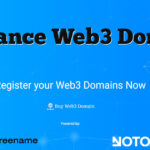Buy a Web3 Insurance Domain
Domains for Web3.0
Now you can register Web3 domains specifically related to insurance.
Our Web3 Insurance Top-Level Domains (TLD)
.insuranceagent
A Web3 top-level (TLD) insurance domain. Ideal for insurance agents who want a great domain.
What is Web 3.0
Web 3.0, also known as Web3 the “Semantic Web” or the “Decentralized Web,” is the next generation of the internet. While Web 1.0 was focused on static websites and Web 2.0 on social media and interactive content, Web3 is expected to be a more intelligent, decentralized, and interconnected web. One of the main characteristics of Web3 is the use of advanced technologies such as artificial intelligence, machine learning, and the blockchain to create a more personalized and secure web experience. With Web3 , users will have greater control over their data and privacy, and be able to access more accurate and relevant information. Web3 is also expected to enable the creation of decentralized applications (dApps), which run on a decentralized network of computers rather than a centralized server. This could potentially lead to a more open and democratic internet, with less control by a few powerful corporations. Overall, Web3 represents a new era of the internet, with more emphasis on user control, security, and decentralized technologies.
With Web3 domains you just pay once to buy them and there are NO renewal fees!
Some Great Insurance Domains
Web3, with its core technologies like blockchain and decentralization, is poised to significantly impact the insurance industry in various ways, both disruptive and beneficial. Here are some critical potential consequences:
Increased efficiency and automation:
- Smart contracts: Self-executing contracts automated by blockchain can streamline processes like claims processing, reducing administrative costs and human error.
- Parametric insurance: Policies based on objective data triggers (e.g., weather data for crop insurance) can eliminate claims disputes and expedite payouts.
- Decentralized data storage: Securely storing data on a blockchain offers better transparency and control for policyholders.
New models and products:
- Micro-insurance: Peer-to-peer platforms can offer smaller, more affordable policies tailored to specific needs.
- Usage-based insurance: Dynamic adjustments based on real-time data (e.g., driving habits) can create fairer premiums.
- Tokenized insurance: NFTs representing policies can improve liquidity and facilitate fractional ownership.
Shifting power dynamics:
- Customer empowerment: Increased data ownership and self-service options can give policyholders more control over their insurance experience.
- Rise of intermediaries: Decentralized marketplaces and DAOs could play a more significant role in connecting insurers and customers, bypassing traditional intermediaries.
- Regulatory challenges: Existing regulatory frameworks may need to adapt to accommodate decentralized protocols and tokenized assets.
Challenges and uncertainties:
- Scalability and adoption: The industry needs to address scalability concerns of blockchain technology and encourage widespread adoption for Web3 insurance to thrive.
- Security and privacy: Ensuring the security of decentralized platforms and protecting user data remains a critical challenge.
- Trust and consumer education: Building trust in new, complex technologies and educating consumers about Web3 concepts are crucial for widespread acceptance.
Overall, Web3 presents exciting opportunities and significant challenges for the insurance industry. The pace and exact nature of its impact will depend on how stakeholders address these challenges and adapt to this evolving landscape.

